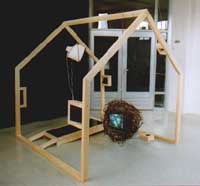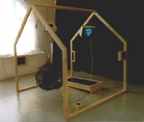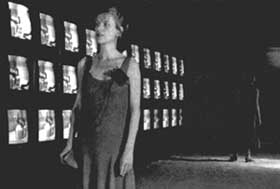| Visual Arts | The Netherlands | ||||||||||||||||||||||||||||||||||||||||||||||
BAFA © 2010. All material here is copyrighted. See conditions above. |
Tina Herslund visual arts / theatre, The Netherlands / Denmark. |

|

| 
| |||||||||||||||||||||||||||||||||||||||||||||
Some house 1999, two video monitors, recorders, ventilators, branches, wood and perspex, 200 x 200 x 250 cm. | |||||||||||||||||||||||||||||||||||||||||||||||
|
Tina began as an assistant stage designer in her home town of Copenhagen (Denmark) in 1980. Later she worked for the
Gladsaxe Theatre as a theatre technician... She then turned to the visual arts... In 1986 she moved to Amsterdam to study theatre at the Rietveld school of Visual Arts... During her study she wrote plays, made video, live performances, sculptures and paintings. | |||||||||||||||||||||||||||||||||||||||||||||||
In 1991, Tina graduated with a book presentation of her play, Tenminste (if only / at least), her only script that has been worked into a full production... When she discovered that it would take about 50,000 guilders to realise Tenminste as a performance, she decided on the book presentation... It contained all stage and audience instructions on the left-hand pages and all the spoken text on the right-hand pages... |

| ||||||||||||||||||||||||||||||||||||||||||||||
Tenminste (if only / at least) by Tina Herslund. | |||||||||||||||||||||||||||||||||||||||||||||||
In 1994, Janny Donker, the director of Loss Theatre in Maastricht commissioned Tenminste
and it was performed nine times over a period of two weeks.
The story of it began with long space of her own studio, into which a voice was placed. Soon this monologue evolved into a dialogue, and then into one where the two women are sisters who talk -often past each other- about a childhood incident concerning the accidental drowning of their brother... The performance makes use of a wall of 3 rows of television sets: a total of sixty-three, plus a set at each end of the space, and sand is placed on the floor. The seating for the audience is at each end of the narrow space so that the audience faces each other and has to look sideways to view the images on the television sets... | |||||||||||||||||||||||||||||||||||||||||||||||
|
a. He couldn't see a dog in front of his nose. That's what they said.
b. Not true. With both his hands held tightly behind his back, he walked out. Didn't touch a chair or table. No vase fell. He stood by the door, quiet. a. With one hand already on the door handle. b. I wanted to grab his hands. a. With a hand and a knee he pushed the door open. b. He was already out the door. If only he had had his hand in mine... | |||||||||||||||||||||||||||||||||||||||||||||||
While the audience hears these texts, they are confronted with images of ordinary daily domestic occupations
in the removed medium of news and fiction -television... The whole piece is choreographically precise... The actresses had to time their performance against each other and against the timing of the video images so that, for example, at the instant they each placed a jam jar on the ground, the same jam jar appeared on all the screens. The cross referencing between the video images and the women's performance, reinforced the concept of the forces of time (the ongoing nature of the video images and the women's memories) and created a sense of a total environment: of image, sound and psychological and physical space... Excerpt from Arts Dialogue, # 40, June 1997, pages 5 - 8. | |||||||||||||||||||||||||||||||||||||||||||||||
|
Arts Dialogue, Dintel 20, NL 7333 MC, Apeldoorn, The Netherlands email: bafa@bahai-library.com |